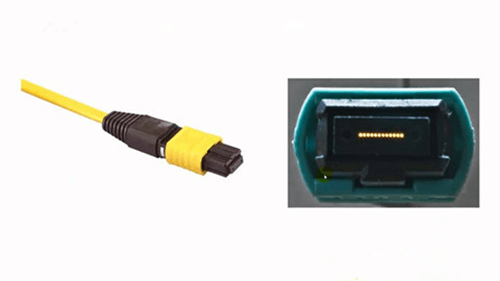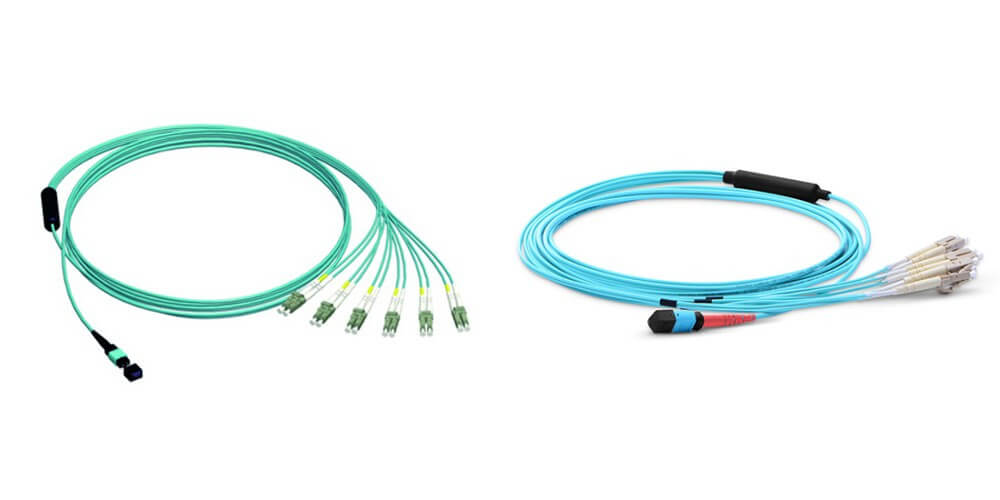With the development of network technology, the demand for high-speed data transmission and data capacity is becoming much greater than ever before. As many data centers are in the process of 10G to 40G and 100G migration, the optical components applied in the cabling system have to be upgraded to meet the requirements. high-density MPO / MTP fiber connectors and patch cords are used more and more widely. among data center managers, since they can provide fast installation, high density and high performance cabling for data centers.
In this post, I’d like to introduce the deployment of MTP/MPO cables (MPO / MTP trunk cable, MPO / MTP harness cable, and MPO / MTP conversion harness) in 10G/40G/100G connection.
Components Used in MPO/MTP Cabling Solutions
MPO/MTP Connector
MPO (multi-fiber push on) connector is a multi-fiber connector which is most commonly defined by two documents: one is IEC-61754-7, the commonly sited standard for MPO connectors internationally; the other one is EIA/TIA-604-5, also known as FOCIS 5, the most common standard sited for in the US. Based on MT ferrule, MPO connector is designed to to enable multi-fiber connectivity for higher density, higher bandwidth based applications. MTP (multi-fiber termination push on) connector is a high performance MPO connector with multiple engineered product enhancements to improve optical and mechanical performance when compared to generic MPO connector. In addition, MTP connector is in complete compliance with all MPO connector standards. Here shows a picture of MPO/MTP connector for you.

MPO/MTP Trunk Cable
MPO/MTP trunk cable, terminated with MPO/MTP connectors at both ends, is available with 12, 16, 24, 48, and 72 fibers. It can create the permanent fiber links between panels in a structured environment. And it is typically used as backbone or horizontal cable interconnections. With efficient plug and play architecture, MPO/MTP trunk cable can greatly reduce the installation and maintenance costs. Here is a figure of MPO/MTP trunk cables for you.

MPO/MTP Harness Cable
MPO/MTP harness cable, also named MTP/MPO fanout cable or MPO/MTP breakout cable, is terminated with a male/female MTP connector on one side and several duplex LC/SC connectors on the other side, providing a transmission from multi-fiber cables to individual fibers or duplex connectors. It is typically used to connect equipment in racks to MPO/MTP terminated backbone cables. MPO/MTP harness cable is designed for high density applications which require high performance and speedy installation without on-site termination. From the figure below, you can have a deep understanding of the structure of MPO/MTP harness cable.
MTP/MPO Conversion Cables
MTP/MPO conversion cables have the same fanout design as MTP/MPO breakout cables but are different in fiber counts and types. They are terminated with MTP/MPO connectors on both ends. Specifically, commonly-used ones are 24-fiber to 2×12-fiber, 24-fiber to 3×8-fiber, 2×12-fiber to 3×8-fiber MTP/MPO conversion cables. They are especially ideal for 10G-40G, 40G-40G, 40G-100G, 40G-120G connections, which eliminate fiber wasting and largely increase the flexibility of the existing 12-fiber and 24-fiber MTP/MPO cabling system.

How to Deploy MTP/MPO Cables in 10G/40G/100G Connections?
Here are some typical applications of MTP/MPO fiber cables in 10G, 40G and 100G connections.
10G-10G Connection
In the following two scenarios, two MTP/MPO cassettes installed in the fiber enclosures are connected by MTP/MPO trunk cables, making the core of the cabling simpler. The front panel of the cassettes is connected upwards to server and downwards to 10G ports of FS S5800-48F4S via OM4 fiber optic cable and 10G transceiver.


10G to 40G Connection: 8-Fiber MTP Harness Cable
8-fiber MTP-LC harness cable is one commonly used solution to directly connect 10G device to 40G device. As the following image shows, the MTP harness cable is in conjunction with a QSFP+ port carrying 40GbE data rates, then breakouts into four LC duplex cables which will be plugged into four 10G SFP+ transceivers.

40G to 40G Connection: 12-Fiber MTP Trunk Cable
For 40G to 40G direct connection, 12-fiber MTP trunk cable is the first choice. In the following scenario, 12-fiber MTP trunk cables are needed to connect the 40G transceivers (four fibers transmit, four fibers receive, leaving four fibers unused), adapting to the QSFP+ ports on the two 40G switches.

120G to 3x40G Connection
In this figure, a MTP/MPO conversion cable connects a CXP 120G SR12 and three 40G QSFP+ SR4 fiber optic transceiver modules to realize the migration from 120G to 40G networking.

10G to 100G Connection: 20-Fiber MTP Harness Cable
CFP is a very popular implementation when deploying 100G network. To achieve 10G to 100G migration, in this scenario, 20-fiber MTP MPO breakout cables will be used(ten fibers for transmit and ten fibers for receive, then breakout into ten duplex LC cables). Simply connect this cable to a CFP transceiver and the customer can access the 10 SFP+ individually transceiver pairs.
100G to 100G Connection: MTP Trunk Cable
For directly connecting switches with QSFP+ ports, 12-fiber MTP trunk cable can be used, while for connecting 100GBase-SR10 CFP equipped devices, 24-fiber MTP trunk cable will be deployed.
Conclusion
With the advent and popularity of cloud computing and big data, 40G and 100G Ethernet is now a trend and hotspot for data center cabling system. Since MPO/MTP connectors are the up-and-coming standard optical interface for 40G and 100G Ethernet network, it is predicted that MPO/MTP cabling solutions will eventually flood the data center. After all, the high fiber count in one connector creates endless possibilities. Karono can provide various specifications of MPO / MTP optical fiber connectors, optical fiber jumpers, and support OEM / ODM customization.
 EN
EN ES
ES DE
DE

erotik izle